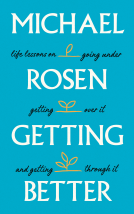
How Do You Live?
The uplifting Japanese classic that has enchanted millions
by Genzaburo Yoshino
This title was previously available on NetGalley and is now archived.
Send NetGalley books directly to your Kindle or Kindle app
1
To read on a Kindle or Kindle app, please add kindle@netgalley.com as an approved email address to receive files in your Amazon account. Click here for step-by-step instructions.
2
Also find your Kindle email address within your Amazon account, and enter it here.
Pub Date 8 Apr 2021 | Archive Date 8 May 2021
Talking about this book? Use #HowDoYouLive #NetGalley. More hashtag tips!
Description
Publishing in English for the very first time, Japan's beloved coming-of-age classic on what really matters in life
The streets of Tokyo swarm below fifteen year-old Copper as he gazes out into the city of his childhood. Struck by the thought of the infinite people whose lives play out alongside his own, he begins to wonder, how do you live?
Considering life's biggest questions for the first time, Copper turns to his dear uncle for heart-warming wisdom. As the old man guides the boy on a journey of philosophical discovery, a timeless tale unfolds, offering a poignant reflection on what it means to be human.
The favourite childhood book of anime master Hayao Miyazaki, How Do You Live? is the basis a highly anticipated film from Studio Ghibli.
Available Editions
| EDITION | Other Format |
| ISBN | 9781846046452 |
| PRICE | £14.99 (GBP) |
| PAGES | 288 |
Featured Reviews
 Tony S, Educator
Tony S, Educator
Let me start by saying that I was not sure about this book at first but I am so glad I stuck with it. The book is superb it covers so many areas from religion, philosophy, economics, politics and overall friendship. It has taken a while to get translated and published in the UK but it is a must read.
It was good to read the history of the book as it gives some detail on why it was written and the context which was also really interesting.
This is a superb book and one that will stay with me for a long time especially the snowball fight and all that goes on around that story.
 Bharti C, Reviewer
Bharti C, Reviewer
A book about life and basic humanity, it is a story, narrative I will happily keep coming back to time and again. The narration of the characters is simple yet most brilliantly effective. Everyone should read this book atleast once.
After learning that this was a Japanese coming of age classic, with the included foreword by Neil Gaiman, I knew I must have it.
We follow the 15-year-old Copper while he thinks, experiences, and discovers all of the nuances of this world. But we do this through his observations, as we're crouching in one corner of his mind watching it all unfold like a motion picture. We go back and forth between his real-life experiences at school, with his friends, and his Uncle's notes, where he carefully and in detail poses explains the ways of the world to Copper and poses some very deep questions.
Copper has a wild imagination and a pure heart. I love how he thinks about people, animals, things, the world around him. We really explore the depths of Copper's mind and watch as the wheels keep turning. We watch Copper arrive to amazing, revolutionary conclusions about his life through some amazing visuals and metaphors.
The book is simply about life - people, things, concepts. How we become who we want to be, how we experience and feel, and why we do so, how we are all interconnected with the world and each other.
It was a very interesting read, tho I have to say I found myself wanting to skim some chapters. It's a very short-paced book, on the shorter side (everything below 300 is on the shorter side for me), so it's really easy to get through it in one sitting.
Overall, I think it's a lovely, but the strange book, that I won't be giving 5 stars to, simply because it didn't affect me in a way five-star books usually do.
“How do you live?”, aside from the book’s title, is also the question asked by the narrator at the end of the story. This book might be a hidden gem in Japanese literature, that it has only been recently translated into English by Bruno Navasky. First published in 1937, the book itself is the voice of a generation living under Imperial Japan which grew increasingly militaristic and authoritarian. Genzaburo Yoshino as the author himself was labelled as subversive by Tokkō — “The Thought Police” — which was a special branch of the police that spied and arrested people with progressive ideas around Japan. He was arrested and released after Japan already engaged in military campaigns that would lead to World War II.
The story follows a 15-year old called Honda Junichi, who was nicknamed Copper (or “Koperu” if we think about the proper pronunciation of the katakana writing) and his uncle about various topics that they discussed. At first, it seems to me that this is the story about relationships between a nephew and his uncle, or about growing up in particular. But there is more dimension to it, which also covers the themes of art, science, language, history, politics, and philosophy to note some. I was not sure if this book is intended for the 15-year-old audience, but surely this is the kind of book that I wish I could have read during the time I questioned my identity and my place in this universe when I was around Copper’s age.
Our main character’s nickname, Copper, is in itself an attempt from Yoshino to incorporate Western thoughts and values into this book. Honda Junichiro was described as a child with curiosities and he kept asking questions that popped up into his head to his uncle. His uncle is kinda like a father figure in this story since Copper’s father passed away two years previously. It makes the story unique since Copper’s uncle accommodated his nephew’s curiosity and provided some answers (and sometimes some questions too) that he could not resist nicknaming his nephew as Copper, from the shortened version of Nicolaus Copernicus — the Renaissance-era astronomer who promoted the idea of heliocentrism that the earth rotates the sun.
The format of this book is rather interesting. There is an all-know narrator, but also much of this book contains exchanges of notes between Copper and his uncle about various topics that they have learned and discussed. Much of the ideas that they discussed originated from Western thoughts, such as the heroism of Napoleon and some socialist egalitarian view that Copper has regarding the fate of his classmate, Uragawa, who had to live in a poorer situation as the child of a tofu seller as compared to his peers. Besides that, Yoshino also promotes the idea of interconnectedness between East and West through drawing the lines of the Gandhara Buddha statues excavated near Peshawar which were first constructed by the Greeks who migrated there during the reign of Alexander the Great. And through that, I get why this book was banned by Imperial Japan and was only widely released after 1945.
Currently, there is an ongoing production of a film adaptation by Hayao Miyazaki and Studio Ghibli which is scheduled to be released in 2023. In the film adaptation, the main character will be someone who is inspired by the original book by Yoshino. It is quite interesting to see how Hayao Miyazaki will take the adaptation since this is said to be one of his favourite books which have influenced his career. Apart from being Hayao Miyazaki’s favourite, I would recommend this book to everyone who struggles to grow up as a human being and need to find some solace in our increasingly segregated modern world.


















